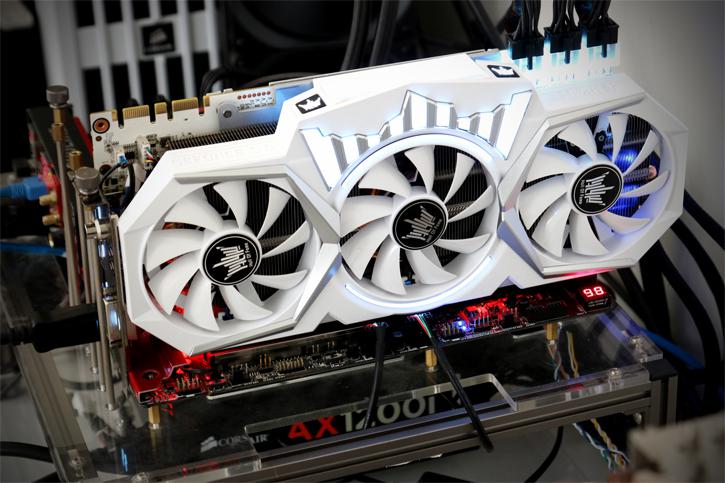Introduction
KFA2 / Galax GeForce GTX 1080 Ti HOF 11GB
Kitt, KITT hello?
It is time once again to take and test the best that Galax / KFA2 has got to offer, their mighty HOF (Hall Of Fame) graphics card, based on that GeForce GTX 1080 Ti. This graphics cards comes 100% customized with factory tweaks, a triple fan and cooler and a very impressive RGB solution with even an LCD display. And it's a beast alright. The new card comes with a three-slot cooler, remains passive up-to roughly 65 Degrees C and has a lot of hidden gems. It has a white design PCB with white elements and a sturdy well vented back-plate. The HOF editions have that little crown as their logo, and as such I am pleased to say that it has pleased the royal queen herself and she has demanded a review here at Guru3D.com, let thy review begin!
It is among the fastest graphics card your money can get you, the Nvidia GeForce GTX 1080 Ti based on Pascal architecture. Armed with 11 GB of GDDR5X graphics memory and an all new GP102-350 GPU, we are certain we're gonna break some records today. It has been eight months since Nvidia released the first GP102 based product, the Titan X. To date, a hugely impressive graphics card that will resemble what we review today and very similar on a lot of levels. Really, the 1080 Ti is the Titan X, just with one GB of that GDDR5X memory less and the one ROP partition tied to it. So let me break it down swiftly and quickly; the new high-end GTX 1080 Ti features 3584 CUDA Cores, 224 Texture Units, a 352-bit memory controller and 11 GB of faster (11 Gbps) GDDR5X memory. The card has the same "GP102" GPU as the TITAN X Pascal, but the GTX 1080 Ti was slightly reconfigured. Most interesting is the 352-bit wide GDDR5X memory interface, this was not expected. This translates into 11 memory chips on the card which run at 11 GHz (GDDR5X-effective), the memory bandwidth is 484 GB/s. This invokes the change in ROP count to 88 (from 96 on the TITAN X Pascal), and the TMU count of 224. The Pascal based unit is a bit of a beast alright, the GPU die size is 471 sq mm. If you look at the wider product stack, then a GeForce GTX 1080 has 2,560 shader processors, the GeForce GTX 1070 has 1,920 shader processors, the GeForce GTX 1060 has 1,280 of them. The Nvidia GeForce 1080 Ti has 3,584 shader processors active inside that GP102 GPU, I say active here deliberately as it still isn't even a fully enabled GPU. This means it is has 28 SMs active (28 streaming multi-processors x 128 shader cores (2x64). The cards will be equipped with fast GDDR5X memory as well for this 11 GB model. That memory is tied to a 352-bit wide bus locked in at 11 GHz (GDDR5X-effective). The combination of that memory type and clock frequency gives the 1080 Ti an effective memory bandwidth of 484 GB/s.
Armed with bulky designed looks you will see a product today that has been overhauled and designed all custom with 16+3 power phases, a rather serious 3-fan / 3 -slot cooling system and sure, 3 8-pin PCIe graphics power connectors as well. It is factory tweaked clock speeds, back-plate and sure, configurable RGB LED lit activities up top and at the front-side. This Pascal 102 GPU empowered product keeps that unit at, or just under, the 67 Degrees C marker depending on game load.
The card at defaults clocks in at a base clock frequency of 1569 MHz and a Boost frequency of 1683 MHz. The memory run an effective data-rate of 11008 MHz. The cooling solution is called TRIMAX design and utilizes three 9m0mm fans. Five heatpipes transfer heat to the fins. This card up-to 60 Degrees C is passive, the fans will not spin. Once they kick in the card remains steady at roughly 67 Degrees C under load, whilst remaining silent. The card is powered by a whopping three 8-pin power connectors. At the top of the card you will notice an LCD display, that shows the HOF logo. Once tied towards Xtreme Tuner software from Galax, you will be able to read out card data like temperatures. Also includes is a nice LUMINHOLD, a LED configurable strip that can help you out stabilizing the card, preventing it from bending. We'll show you that in the photo-shoot of course. Yeah we have a lot to talk about alright, let's dive into the review.


